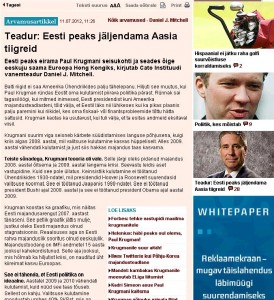Last month, I exposed some major errors that Paul Krugman committed when he criticized Estonia for restraining the burden of government spending.
 My analysis will be helpful since I am now in Estonia for a speech about economic reform, and I wrote a column that was published yesterday by the nation’s main business newspaper.
My analysis will be helpful since I am now in Estonia for a speech about economic reform, and I wrote a column that was published yesterday by the nation’s main business newspaper.
But just in case you’re one of the few people in the world who isn’t fluent in the local language, the Mises Institute Estonia was kind enough to post an English version.
Here are some of the key points I made. I started by explaining one of Krugman’s main blunders.
Krugman’s biggest mistake is that he claimed that spending cuts caused the downturn, even though the recession began in 2008 when government spending was rapidly expanding. It wasn’t until 2009 that the burden of government spending was reduced, and that was when the economy began to grow again. In other words, Krugman’s Keynesian theory was completely wrong. The economy should have boomed in 2008 and suffered a recession beginning in 2009. Instead, the opposite has happened.
I then pointed out that Estonia’s long-run performance has been admirable.
…the nation’s long-run economic performance is quite exemplary. Economic output has doubled in just 15 years according to the International Monetary Fund. Over that entire period – including the recent downturn, it has enjoyed one of the fastest growth rates in Europe.
But I’m not a mindless cheerleader (though I might become one if any of the local women gave me the time of day), so I took the opportunity to identify areas where public policy needs improvement.
This doesn’t mean Estonia’s policy is perfect. Spending was reduced in 2009 and 2010, but now it is climbing again. This is unfortunate. Government spending consumes about 40 percent of GDP, which is a significant burden on the private sector.
Being a thoughtful guy, I then made suggestions for pro-growth changes.
Estonia should copy the Asian Tiger economies of Singapore and Hong Kong. These jurisdictions have maintained very high growth for decades in part because the burden of the public sector is only about 20 percent of GDP. …Estonia already has a flat tax, which is very important for competitiveness. The key goal should be to impose a spending cap, perhaps similar to Switzerland’s very successful “debt brake.” Under the Swiss system, government spending is not allowed to grow faster than population plus inflation. And since nominal GDP usually expands at a faster rate, this means that the relative burden of government spending shrinks over time. By slowly but surely reducing the amount of GDP diverted to fund government, this would enable policymakers to deal with the one area where Estonia’s tax system is very unfriendly. Social insurance taxes equal about one-fourth of the cost of hiring a worker, thus discouraging job creation and boosting the shadow economy.
And I elaborated on why reform of social insurance is not just a good idea, but should be viewed as an absolute necessity.
Reducing the heavy burden of social insurance taxes should be part of a big reform to modernize programs for healthcare and the elderly. A major long-term challenge for Estonia is that the population is expected to shrink. The World Bank and the United Nations both show that fertility rates are well below the “replacement rate,” meaning that there will be fewer workers in the future. That’s a very compelling reason why it is important to expand personal retirement accounts and allow the “pre-funding” of healthcare. It’s a simple matter of demographic reality.
In other words, Estonia doesn’t have a choice. If they don’t reform their entitlement programs, the burden of government spending will rise dramatically, which would mean a higher tax burden and/or substantial government debt.
We also need entitlement reform in the United States. Our demographics aren’t as bad as Estonia’s, but we all know – as I explained in my post about Cyprus – that bad things happen sooner or later if government spending grows faster than the economy’s productive sector.

